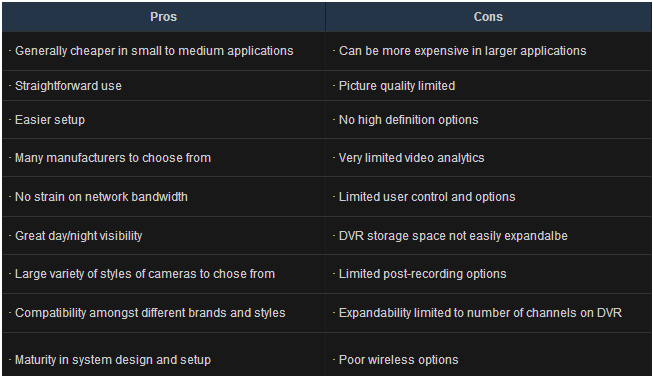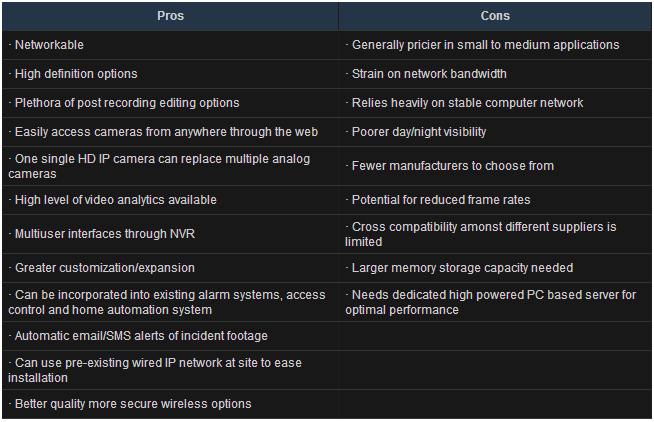Standard IP cameras come in a variety of shapes and sizes, ranging from domes to bullets to boxes and even PTZs (pan-tilt-zoom). As aforementioned, the IP in IP cameras stands for Internet Protocol, which refers to the method in which the cameras transmit their signals across the system. Utilizing a digital connection and specialized software IP cameras are able to connect directly into your computer, allowing the user to access the camera images from virtually anywhere in the world as long as they have a broadband internet connection. Using a special file compression format (H.264 or MPEG4) allows the cameras to capture a huge amount of information, while not completely consuming all your computers resources and memory. Most IP cameras record at a standard 640 x 480 resolution (roughly 500 TVL) at 30 frames per second; however, as we’ll see in the next section, megapixel cameras are a new breed of IP cameras that have brought HD (high definition) into the surveillance game.
Also known as high definition cameras, they are the latest in surveillance camera technology. Similar to the benefits of switching to an HD television set, having megapixel surveillance cameras will drastically increase the quality of your recorded images as well as giving you an array of options previously unavailable with standard definition cameras. Megapixel cameras come in a variety of styles, including dome, bullet, box and PT (pan-tilt). To give you a better understanding of the power of a megapixel camera, refer to the chart below for brief overview of their stats:

Great, so what does this all mean for you? Well, we know that more pixels are better, and we know that megapixel cameras have more pixels then analogue cameras, but how does this affect you in the real world? Good question. First off, it’s very important to understand the concept and relationship of coverage as defined by “pixels-per-square foot”, which is essentially how many pixels you need to have per square foot in order to get a usable image. For example, if you have a parking lot that is 100 feet wide and 40 feet deep, how many total pixels do you need in order to cover the entire parking lot to achieve your desired picture quality? The generally accepted standard is this:
- Allows for recognition of male/female, colour of clothes, approximate height, colour of skin, etc…
- Allows for basic facial recognition, license plate retrieval, point-of-sale tracking, etc…
- Allows for detailed facial recognition such as scars, birth marks, eye colour, tattoos, etc…
The first number in the cameras resolution tells you how many horizontal pixels the camera has, the second number is the amount of vertical pixels the camera has. For instance a standard analogue camera has 640 pixels of horizontal definition and 480 pixels of vertical resolution, whereas a 5 megapixel camera has 2560 pixels of horizontal resolution and 1920 pixels of vertical resolution. For simplicity we will only discuss the horizontal and vertical fields of view for now, however for a true analysis you need to factor in the cameras height as well. With that said, let’s look at an example to bring this all together.
Back to your parking lot which we know is 100 feet wide and 40 feet deep, and let’s say you want to be able to have forensic level detail on the entire parking lot at all times (40 pixels of resolution per foot). Therefore we know that you will need 100 (feet wide) x 40 (pixels per foot for forensic level detail) which equals 4,000 horizontal pixels of resolution and 40 (feet deep) x 40 (pixels per foot for forensic level detail) which equals 1,600 vertical pixels covering the parking lot in order to get facial and license plate recognition capability. We can then multiply those two numbers to find out how many total pixels we will need to cover the parking lot with in order to achieve our goal of forensic level detail across the entire parking lot. Therefore 4,000 x 1,600 = 6,400,000 total pixels needed to cover parking lot and achieve forensic level detail.
![]()
The next step is to determine what resolution cameras you want to use and how many of them you will need. We determine this by dividing the total amount of pixels needed to cover the area by the total amount of pixels offered by the camera in question. In this example, if we wanted to use standard analogue cameras with a resolution of 640×480, and we know that each camera provides us with 307,200 pixels of total resolution, then we know that we will need approximately 21 analogue cameras to cover the parking lot to achieve forensic level detail [6,400,000 (total pixels) divided by 307,200 (total pixels per camera) = 20.8, we will round up to 21 to be safe]. So now we know that if we want forensic level detail in our surveillance images, and we want to use standard analogue cameras, we need to use 21 cameras to cover the entire parking lot.
![]()
Now let’s compare that result to that of a 3.1 megapixel camera. At first glance you might look at the respective resolutions of the two cameras (640×480 vs. 2048×1536) and think that a 3.1 megapixel camera is just slightly more then 3 times are powerful as a standard analogue camera, however, you’d be wrong. Because of the multiplicative properties of the resolutions, in order to accurately assess one cameras power in relation to the other, we must look at total pixels per image offered, and not just one’s resolution in relationship to the other. Referring back to the original chart in this section, we see that an analogue camera provides us with 307,200 total pixels per image, whereas a 3.1 megapixel camera offers us 3,145,728 pixels per image, that’s over 10 times the amount of pixels, which means ten times more information, which means it’s 10 times more powerful. Getting back to our parking lot, and doing a little bit of math, we find that if we were to use a 3.1 megapixel camera setup instead of analogue cameras, we would only need TWO 3.1 megapixel cameras to cover the same amount of ground and achieve comparable levels of image quality [6,400,000 (total pixels) divided by 3,145,728 (total pixels per 3.1 Megapixel camera) = 2.03, approx. 2]
![]()
So there in lies one of the major differences between megapixel cameras and analogue cameras, generally, you can cover much more ground with fewer cameras when using a megapixel camera system as compared to an analogue camera system, all the while achieving similar if not greater picture quality.
Another advantage of megapixel cameras is their ability to view a large area all at once, as well as being able to zoom into any area of the picture to get greater detail, even after an incident has occurred. For example, let’s get back to our parking lot, in the past if you wanted to cover the entire parking lot we now know that we would need at least 21 analogue cameras, or perhaps you could use a couple of PTZ cameras (Pan-Tilt-Zoom). PTZ’s are useful because they give the end user the ability to move the cameras around using a joystick and keypad, PTZ’s are also generally equipped with high powered optical zoom lens, which work great for viewing objects at great distances. Over the past decade or so, PTZs became popular as one PTZ camera could essentially do the same job as multiple stationary analogue cameras could (keep in mind though, PTZ’s still use analogue signals as well). One or two PTZs could monitor an entire parking lot easily using its pan and tilt function, combined with its powerful optical zoom. However they have serious limitations. First off, someone needs to man the camera to constantly monitor the area its covering, second, if the camera is pointed at the north end of the parking lot and something were to happen at the south end of the lot, chances are the PTZ would miss it, and lastly, if the camera wasn’t zoomed in to a particular area while an incident occurs, the images could not be digitally enhanced after the fact as the image just did not contain enough pixel information to allow for a useable digital zoom.
This is where megapixel cameras shine. Getting back to our example, imagine we had our two 3.1 megapixel cameras overlooking the entire parking lot, their point of view never changes, the two cameras cover the entire lot perfectly and if something were to happen at any place in the parking lot, the megapixel cameras would record it. After which point that footage can be brought up and digitally analyzed, zoomed in, or enhanced to get greater detail of the incident, after it occurred. Because of the drastic increase in overall pixels in any given image, images recorded on megapixel cameras lend themselves to post incident analysis much better then analogue cameras do. Megapixel cameras give you retroactive solutions, whereas standard analogue or even PTZ cameras required proactive solutions in order to achieve a favorable solution or outcome to a given situation.
One of the last areas where IP megapixel cameras outperform analogue cameras is in the field of video analytics. You may have heard this term being discussed as of late, but may not be entirely sure what it refers to. A basic definition of video analytics is the ability of a camera, through the use of an embedded computer chip in the camera itself or through the use of specialized software, to analyze video for specific data, behaviour, objects or attitudes. Examples of video analytics include, license plate retrieval, facial recognition, motion detection, congestion/density detection, counter flow monitoring, and virtual tripwire, where a virtual line is drawn in the cameras field of view and if the line is passed an alarm is triggered. These are just some of the solutions that video analytics can supply. The possibilities are truly endless with this emerging new technology. However, as with all new technologies in their infancy, there are issues surrounding analytics, involving false alarms, proper deployment, and a realistic set of expectations by both the client and the installer.
With all that being said, megapixel cameras do have some limitations as well. First off, they are not particularly good in darkness. Whereas analogue cameras have either powerful IR sensors that illuminate the picture for the lens to capture, or use a very sensitive day/night lens to capture images in total darkness, megapixel cameras don’t have either of these luxuries. For this reason, megapixel cameras are best used in well lit areas that have a constant light source 24 hours a day. Second, most megapixel cameras don’t run at 30 frames per second as do analogue cameras. 1.3 and some 2 megapixel cameras are capable of running at 30 frames per second, however due to the increase in overall information being transmitted with higher megapixel cameras, any camera over 2 MP generally won’t be able to run at 30 frames per second. The information transfer is just too great for most systems, and for this reasons most higher end megapixel cameras run anywhere from 5-20 frames per second (the greater the amount of megapixels, the fewer frames per second will be achieved) The trade off is acceptable in most circumstances as a 5 MP camera running at 10 frames per second is still able to capture far more usable data then a VGA 640 x 480 analogue camera is able to capture running at 30 frames per second. A third concern with IP cameras is the available network bandwidth at the given location. Because IP cameras do not use a standalone DVR to record the images, rather they connect directly into your computers network; it’s important that you make sure your system can handle the extra information coming in from the cameras. Attempting to connect too many IP cameras to a computer system with limited network bandwidth can cause a failure in the entire system. These are issues that are dealt with on an individual basis.
Lastly, there is the issue of price. Some companies will tell you that bar none, megapixel IP cameras are more expensive then analogue cameras, period. Other companies will tell you that megapixel IP cameras can actually save you money by using fewer cameras overall. The truth is, each project is different and there is no definitive answer to that question. Anyone telling you one way or the other is probably just trying to sell you on whatever it is they’re promoting. There will be times where megapixel cameras will be more expensive, but necessary, and other times when using fewer megapixel cameras will actually end up saving you money, and other times when a simple analogue system is all you need. The important thing to remember is that each application is different, and that no one solution is perfect for every situation, which is why we encourage you to give us a call and speak with one of our experts to figure out which system is right for you.
ANALOG CAMERA SYSTEM

DIGITEL IP CAMERA SYSTEM

Unlock the power of precision in your real estate investments with the cap rate calculator from Lead Hustler. Say goodbye to guesswork and hello to precise insights for your property ventures. Seize this exclusive opportunity now!












